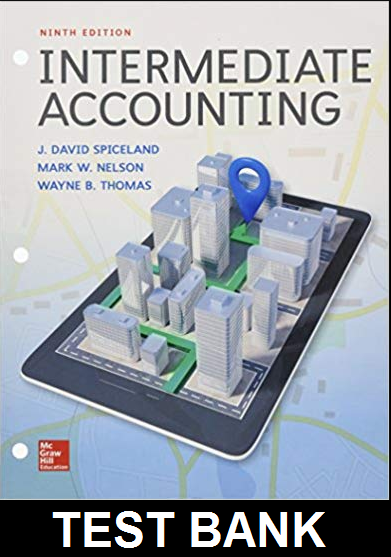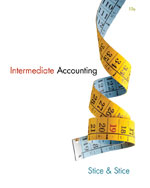Test Bank For Intermediate Accounting 9th Edition By Spiceland
Original price was: $55.00.$25.00Current price is: $25.00.
Test Bank For Intermediate Accounting 9th Edition By Spiceland can help students improve their understanding of accounting concepts and prepare for exams. The Test Bank provides a variety of questions that cover all the key topics in the textbook.
In addition, the Test Bank includes answer explanations to help students better understand the material. With the Test Bank, students will have a valuable resource to use as they study for their upcoming exams.
Digital item No Waiting Time Instant Download
ISBN10: 125972266X, ISBN13: 9781259722660
Description
Test Bank For Intermediate Accounting 9th Edition By Spiceland
Chapter 02 Review of the Accounting Process Answer Key True / False Questions
1. Owners’ equity can be expressed as assets minus liabilities.
TRUE
AACSB: Reflective Thinking AICPA: BB Critical Thinking Accessibility: Keyboard Navigation Blooms: Remember
Learning Objective: 02-01 Analyze routine economic events-transactions and record their effects on a company’s financial position using the accounting equation format.
Level of Difficulty: 1 Easy
Topic Area: Accounting equation
2. Debits increase asset accounts and decrease liability accounts.
TRUE
AACSB: Reflective Thinking AICPA: BB Critical Thinking Accessibility: Keyboard Navigation Blooms: Remember
Learning Objective: 02-01 Analyze routine economic events-transactions and record their effects on a company’s financial position using the accounting equation format.
Level of Difficulty: 1 Easy
Topic Area: Account relationships and records
3. Balance sheet accounts are referred to as temporary accounts because their balances are always changing.
FALSE
AACSB: Reflective Thinking AICPA: BB Critical Thinking Accessibility: Keyboard Navigation
2-1
Blooms: Remember
Learning Objective: 02-01 Analyze routine economic events-transactions and record their effects on a company’s financial position using the accounting equation format.
Level of Difficulty: 1 Easy
Topic Area: Account relationships and records
4. After an unadjusted trial balance is prepared, the next step in the accounting processing cycle is
the preparation of financial statements.
FALSE
AACSB: Reflective Thinking AICPA: BB Critical Thinking Accessibility: Keyboard Navigation Blooms: Remember
Learning Objective: 02-01 Analyze routine economic events-transactions and record their effects on a company’s financial position using the accounting equation format.
Level of Difficulty: 1 Easy
Topic Area: Accounting processing cycle steps
5. Adjusting journal entries are recorded at the end of any period when financial statements are prepared.
TRUE
AACSB: Reflective Thinking AICPA: BB Critical Thinking Accessibility: Keyboard Navigation Blooms: Remember
Learning Objective: 02-04 Identify and describe the different types of adjusting journal entries. Level of Difficulty: 1 Easy
Topic Area: Analyze updating-Record adjusting entry
6. Accruals occur when the cash flow precedes either revenue or expense recognition.
FALSE
AACSB: Reflective Thinking AICPA: BB Critical Thinking Accessibility: Keyboard Navigation Blooms: Remember
Learning Objective: 02-04 Identify and describe the different types of adjusting journal entries.
2-2
Level of Difficulty: 1 Easy
Topic Area: Analyze the updating-Identify type of adjustment
7. The adjusted trial balance contains only permanent accounts.
FALSE
AACSB: Reflective Thinking AICPA: BB Critical Thinking Accessibility: Keyboard Navigation Blooms: Remember
Learning Objective: 02-05 Record adjusting journal entries in general journal format; post entries; and prepare an adjusted trial balance.
Level of Difficulty: 1 Easy
Topic Area: Trial balance―Adjusted
8. The income statement summarizes the operating activity of a firm at a particular point in time.
FALSE
AACSB: Reflective Thinking AICPA: BB Critical Thinking
AICPA: FN Measurement Accessibility: Keyboard Navigation Blooms: Remember
Learning Objective: 02-06 Describe the four basic financial statements. Level of Difficulty: 1 Easy
Topic Area: Financial statement―Income Statement
9. The balance sheet can be considered a change or flow statement.
FALSE
AACSB: Reflective Thinking AICPA: BB Critical Thinking
AICPA: FN Measurement Accessibility: Keyboard Navigation Blooms: Remember
Learning Objective: 02-06 Describe the four basic financial statements. Level of Difficulty: 1 Easy
Topic Area: Financial statement―Balance sheet
2-3
10. The statement of cash flows summarizes transactions that caused cash to change during a reporting period.
TRUE
AACSB: Reflective Thinking AICPA: BB Critical Thinking
AICPA: FN Measurement Accessibility: Keyboard Navigation Blooms: Remember
Learning Objective: 02-06 Describe the four basic financial statements. Level of Difficulty: 1 Easy
Topic Area: Financial statement―Cash flow
11. The statement of shareholders’ equity discloses the changes in the temporary shareholders’ equity accounts.
FALSE
AACSB: Reflective Thinking AICPA: BB Critical Thinking
AICPA: FN Measurement Accessibility: Keyboard Navigation Blooms: Remember
Learning Objective: 02-06 Describe the four basic financial statements. Level of Difficulty: 2 Medium
Topic Area: Financial statement―Shareholders’ equity
12. The post-closing trial balance contains only permanent accounts.
TRUE
AACSB: Reflective Thinking AICPA: BB Critical Thinking Accessibility: Keyboard Navigation Blooms: Remember
Learning Objective: 02-07 Explain the closing process. Level of Difficulty: 1 Easy
Topic Area: The closing process
2-4
13. The closing process brings all temporary accounts to a zero balance and updates the balance in
the retained earnings account.
TRUE
AACSB: Reflective Thinking AICPA: BB Critical Thinking Accessibility: Keyboard Navigation Blooms: Remember
Learning Objective: 02-07 Explain the closing process. Level of Difficulty: 1 Easy
Topic Area: The closing process
14. A reversing entry at the beginning of a period for salaries would include a debit to salaries expense.
FALSE
AACSB: Reflective Thinking AICPA: BB Critical Thinking Accessibility: Keyboard Navigation Blooms: Remember
Learning Objective: 02-Appendix 2B Reversing Entries. Level of Difficulty: 2 Medium
Topic Area: Reversing entries–Appendix B
15. The sale of merchandise on account would be recorded in a sales journal.
TRUE
AACSB: Reflective Thinking AICPA: BB Critical Thinking Accessibility: Keyboard Navigation Blooms: Remember
Learning Objective: 02-Appendix 2C Subsidiary Ledgers and Special Journals. Level of Difficulty: 1 Easy
Topic Area: Subsidiary ledger-Special journal–App C





Be the first to review “Test Bank For Intermediate Accounting 9th Edition By Spiceland”